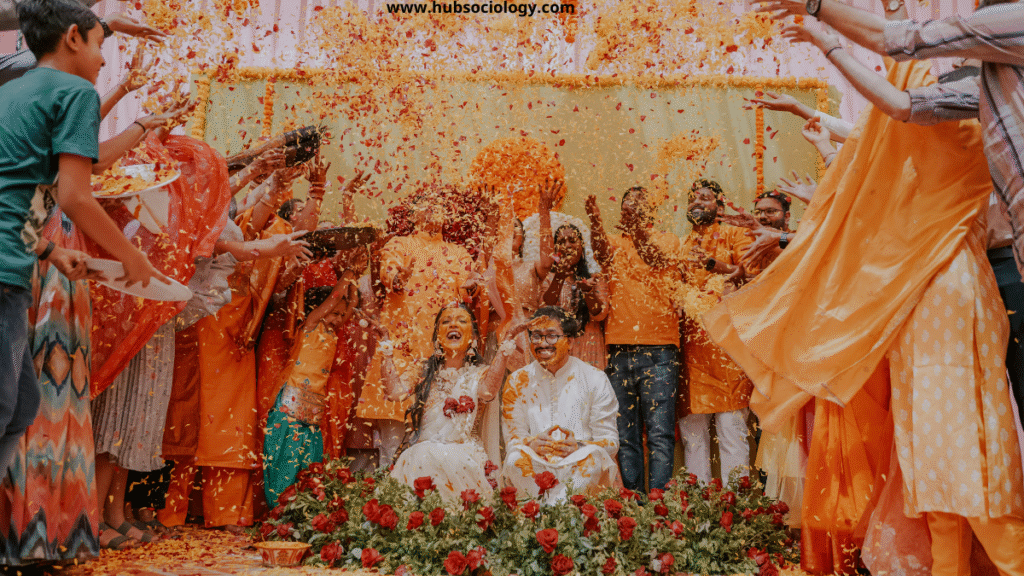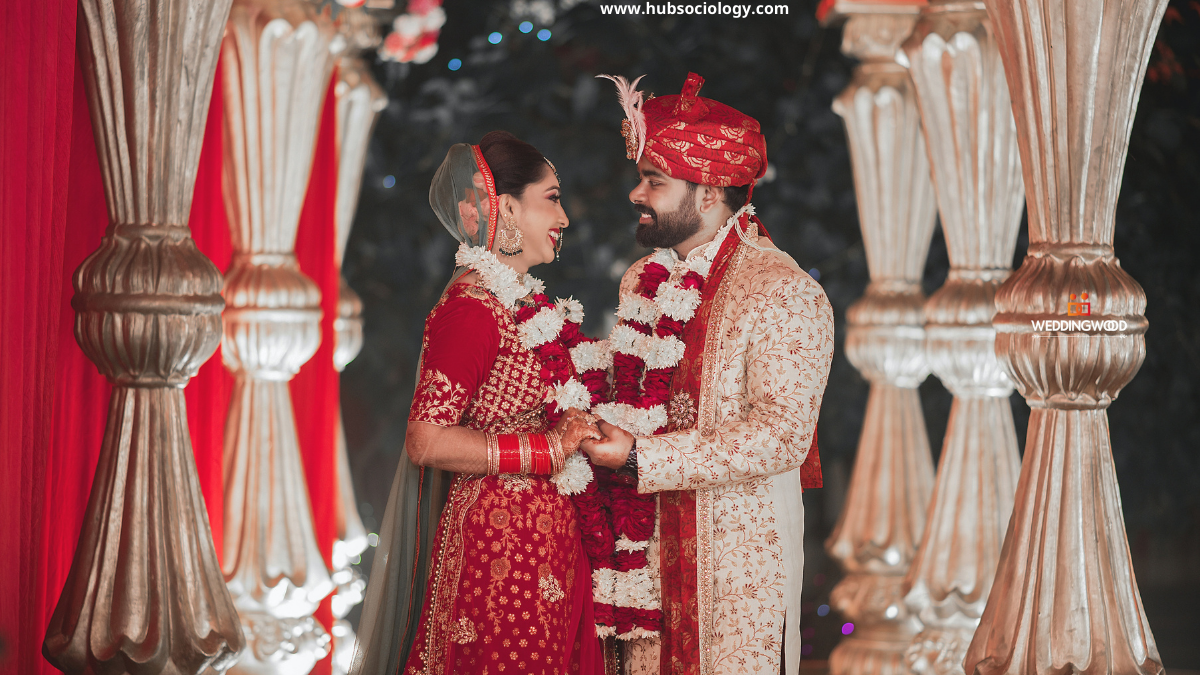Introduction on Marriage in India
In the vast and diverse landscape of Indian society, marriage is far more than a mere personal commitment or a religious ceremony; it is a fundamental social institution. It serves as the cornerstone of social structure, the primary mechanism for alliance between families, and a critical vehicle for the perpetuation of culture, caste, and kinship lines. From a sociological perspective, understanding marriage in India requires moving beyond the Western ideal of a love-based union to appreciate its deep-rooted functions in maintaining social order, economic stability, and cultural continuity. This article delves into the sociological meaning of marriage in India and explores its various traditional and evolving types.

The Sociological Meaning of Marriage in India
Sociologists define marriage as a socially approved, often legally sanctioned, union between individuals, conferring mutual rights and obligations. In the Indian context, this definition expands to encompass a complex web of social responsibilities. The meaning of marriage is deeply intertwined with the country’s religious, cultural, and social fabric.
Key sociological functions of marriage in India include:
- Regulation of Sexual Relations: Marriage provides the legitimate and socially approved context for sexual relations and procreation. It institutionalizes sexuality, channeling it in a way that maintains social order and defines lines of descent and inheritance.
- Foundation of the Family and Kinship: Marriage is the approved way to establish a family. In India, it is rarely a union of two individuals but rather an alliance between two families, and often, two kinship groups (lineages or clans). It creates new social networks and reinforces existing ones, expanding the web of kinship through affinal (marital) ties.
- Perpetuation of Caste and Gotra: The Hindu marriage system, followed by the majority, is profoundly governed by the rules of caste endogamy (marrying within one’s caste) and exogamy (marrying outside certain groups). A key rule is sagotra exogamy, prohibiting marriage within the same gotra (a patrilineal clan tracing descent from a common mythical ancestor). This practice ensures the biological and social vitality of the caste group while preventing inbreeding.
- Economic Arrangement and Division of Labor: Traditionally, marriage has been a critical economic arrangement. It involves the exchange of wealth through dowry or bride price, solidifying economic ties between families. It also establishes a clear division of labor, with socially prescribed roles for husbands (breadwinner) and wives (homemaker and caregiver), though this is rapidly changing in urban areas.
- Social Legitimacy and Status Conferral: Marriage confers social status and legitimacy upon the couple and their offspring. It is a key rite of passage that marks an individual’s entry into full social adulthood. For women, particularly in traditional settings, marriage is often the defining event of their social identity, moving from their natal home (maika) to their marital home (sasural).
Traditional Types of Marriage in India
The ancient Hindu legal text, the Manusmriti, and other Dharmashastras, classified marriage into eight forms based on how the union was arranged and the rituals involved. These can be broadly categorized based on whether they are approved or disapproved by orthodox tradition. Sociologists study these types to understand the historical and normative foundations of the institution.
The Approved (Prashasta) Forms:
These forms were considered righteous and involved parental approval and Vedic rituals.
- Brahma Marriage: Considered the most superior form. In this, a father gifts his daughter (kanyadaan) to a man of good character and learning from a similar caste, without demanding any reciprocal gift or payment. It epitomizes the ideals of duty, sacrifice, and sanctity.
- Daiva Marriage: Here, a father gifts his daughter to a priest who officiates at a sacrificial ritual. This was considered less honorable than Brahma marriage, as it was seen as utilizing the daughter for a ritual purpose.
- Arsha Marriage: In this type, the groom gives a cow and a bull to the bride’s father in exchange for the bride. This was not a commercial sale but a symbolic ritual acknowledging the economic loss to the bride’s family.
- Prajapatya Marriage: Similar to Brahma, but the father gifts the couple with a blessing to perform their civic and religious duties together (dharma and praja).
The Disapproved (Aprashasta) Forms:
These forms deviated from the ideal norms and were often practiced by non-Brahmanical or lower caste communities.
- Asura Marriage: This was a marriage by purchase, where the groom offered wealth and gifts to the bride’s father and the bride herself. While condemned in texts, sociologists note its prevalence in various forms, akin to a bride-price system found in many tribal and peasant communities.
- Gandharva Marriage: This is the classical equivalent of a love marriage or marriage by consent. It was accomplished solely by mutual consent, without rituals, witnesses, or parental approval. While romanticized in literature (e.g., Shakuntala and Dushyanta), it was socially frowned upon as it bypassed familial and communal control.
- Rakshasa Marriage: This involved the forcible abduction of the bride, often after a battle with her family. It reflected a martial culture but was unequivocally condemned in the shastras.
- Paishacha Marriage: The most condemned form, which involved seducing or marrying a girl while she was asleep, intoxicated, or mentally incapacitated. It is akin to what modern society would classify as a grievous crime.
While these eight forms are not strictly practiced today, their sociological legacy persists. The preference for arranged, parent-sanctioned marriages (a modern evolution of Brahma/Prajapatya ideals) over self-arranged “love marriages” (Gandharva) remains a dominant theme in contemporary Indian society.
Contemporary Typologies and Evolving Practices on Marriage in India
Modern sociology classifies marriages in India based on current practices, rules of partner selection, and number of partners. The traditional Vedic types have given way to these more functional categories.

- Arranged Marriage: The predominant form. Partners are selected by families based on criteria like caste, sub-caste, economic status, education, horoscope compatibility, and family background. It is seen as a contract between families, with the couple’s consent becoming increasingly, though not always, central.
- Love Marriage (Self-Arranged Marriage): A growing phenomenon, particularly in urban centers. Partners choose each other based on romantic love and personal compatibility, often against the wishes of their families. This represents a shift from institutional to companionate marriage, emphasizing individual choice over familial duty.
- Inter-Caste and Inter-Religious Marriage: These marriages challenge the foundational principle of caste endogamy and religious homogeneity. While still facing significant social opposition and even violence (“honor killings”), their increasing occurrence signals a slow but sure transformation in social attitudes, driven by education, urbanization, and legal protections like the Special Marriage Act, 1954.
- Monogamy: The only legally permitted form of marriage across all religions in India today. It is the practice of having only one spouse at a time.
- Polygamy: Though illegal for Hindus under the Hindu Marriage Act (1955), polygyny (a man having more than one wife) is still permitted under Muslim Personal Law, subject to certain conditions. Polyandry (a woman having more than one husband) is extremely rare but practiced in a few communities, like the Toda of Nilgiris and some groups in Jaunsar-Bawar. Sociologists study these practices to understand the interplay of religion, custom, and law.
- Same-Sex Marriage: A fiercely debated and emerging category. While not legally recognized, the existence of same-sex unions and the ongoing legal and social struggle for their validation represent the most recent frontier in the evolution of the institution of marriage in India, pushing against its traditionally heteronormative definition.
Conclusion of Marriage in India
From a sociological standpoint, marriage in India is a dynamic institution caught between the powerful forces of tradition and modernity. While its core functions of establishing families and creating kinship alliances remain, the means to achieve them are rapidly changing. The rise of love marriages, the slow increase in inter-caste unions, and the debate around same-sex marriage indicate a gradual shift from an institution focused on social reproduction to one increasingly accommodating individual agency, choice, and emotional fulfillment.

However, the continued prevalence of arranged marriages, the persistence of caste endogamy, and the horror of “honor killings” remind us that the traditional, institutional hold of marriage remains potent. The Indian marriage, therefore, is not a monolithic entity but a living, breathing tapestry woven with threads of ancient norms, religious edicts, and modern aspirations, offering a fascinating lens through which to observe the broader sociological evolution of Indian society itself.
Do you like this this Article ? You Can follow as on :-
Facebook – https://www.facebook.com/hubsociology
Whatsapp Channel – https://whatsapp.com/channel/0029Vb6D8vGKWEKpJpu5QP0O
Gmail – hubsociology@gmail.com
Topic Related Questions on Marriage in India
5 Marks Questions on Marriage in India (Write in about 50-80 words)
- Define marriage from a sociological perspective in the Indian context.
- List any five traditional forms of Hindu marriage as per the Dharmashastras.
- What is the primary difference between Brahma and Daiva marriage?
- Briefly explain the concepts of caste endogamy and gotra exogamy.
- What is the sociological significance of kanyadaan in the Brahma marriage?
- Differentiate between Asura and Gandharva forms of marriage.
- State two key sociological functions of marriage in India.
10 Marks Questions on Marriage in India (Write in about 150-200 words)
- Discuss marriage as a social institution in India, highlighting its key sociological functions.
- Elaborate on the Vedic classification of approved (Prashasta) forms of marriage. Which of these is considered the most ideal and why?
- Analyze the disapproved (Aprashasta) forms of marriage, explaining the social reasons behind their condemnation in ancient texts.
- “Marriage in India is an alliance between two families, not just two individuals.” Critically examine this statement from a sociological viewpoint.
- How do arranged marriages and love marriages represent the tension between tradition and modernity in Indian society?
- Explain the rules of partner selection in traditional Hindu marriage, focusing on endogamy and exogamy.
- Discuss the economic aspects of marriage in India, referencing concepts like dowry and bride price.
15 Marks Questions on Marriage in India (Write in about 250-300 words)
- Critically examine the different types of marriages in India, from the ancient Vedic classification to contemporary practices. How do these types reflect the changing social norms?
- “The institution of marriage in India is a cornerstone for the perpetuation of caste and kinship systems.” Discuss this statement in detail, substantiating with sociological concepts.
- Analyze the evolving nature of marriage in modern India. What factors are responsible for the shift from institutional to companionate marriage? Discuss the challenges and manifestations of this change.
- Compare and contrast the structural-functional and conflict perspectives on the institution of marriage in India. How would each view practices like dowry and caste endogamy?
- Discuss the legal and social challenges faced by inter-caste and same-sex marriages in India. What do these challenges reveal about the deep-rooted social fabric of the country?
- Write a detailed note on polygamy and its legal status in India. How does its permissibility under certain personal laws create a sociological debate on uniformity and gender justice?
- Is the institution of marriage in India weakening or strengthening? Present a sociological argument for both sides, using examples from contemporary trends.

1 thought on “The Sociological Tapestry of Marriage in India: Meaning, Types, and Transformations”